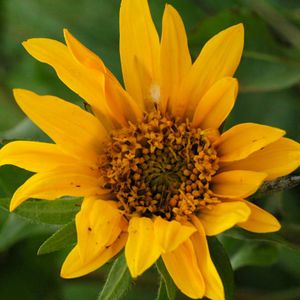Wyethia angustifolia
- Scientific Name: Wyethia angustifolia
- Family: Asteraceae
- Common Names: mule’s ears, California compass-plant, narrowleaf wyethia.
- Synonyms/Misapplications: Alarconia angustifolia DC.
- Codon: WYEANG
Contents
Taxonomy
| Scientific classification | |
|---|---|
| Kingdom: | Plantae |
| Subkingdom: | Viridiplantae |
| Phylum: | Tracheophyta |
| Subphylum: | Spermatophytina |
| Class: | Magnoliopsida |
| Subclass: | Asteranae |
| Order: | Asterales |
| Family: | Asteraceae |
| Genus: | Wyethia Nutt. |
| Species: | Wyethia angustifolia (DC) Nutt. |
| Synonyms | |
| |
Description
Native, perennial herb growing from a taproot with a large, yellow pseudanthium, to 90 cm tall.[2] Stems and leaves pubescent,[3] stems stout.[2] Basal leaves simple, elongate, petiolate, tapering at both ends, to 50 cm long;[2] cauline leaves smaller, alternate, often sessile.[3] Pseudanthium radiate, usually solitary;[4] phyllaries linear to lanceolate, to 30 mm; ray florets 8-21, 15-45 mm; disk florets 10-11 mm;[5] receptacle convex, paleate;[4] calyx hairy; stamens 5, sagittate, epipetalous, anthers connate around style; pistil 2-carpellate with bifid style, 2 stigmas and an inferior ovary with basal placentation[4] becoming a compressed-quadrangular achene.[2]
Bloom Period
April-July[2]
Distribution
Occurring west of the Cascades crest in southwestern Washington, and east in the Columbia River Gorge; Washington to California.[2]
Habitat
Low elevation meadows and moist, open hillsides.[2]
Uses
Raw stems used for food; seeds used for pinole (food) and dried for winter use; decoction of leaves used to reduce fever and induce perspiration; decoction of roots taken as an emetic; poultice of root lather used for lung problems and to draw blisters.[6]
The seed can be dried, ground into a powder and used as a thickener in soups or can be added to cereal flours when making bread etc. Young leaves can be eaten raw. A lemon-yellow dye is obtained from the flowers. A gold to brass dye is obtained from the flowers, leaves and stems.[6]
Propagation
Soak or stratify seed. Seeds should receive cool-moist stratification 90-120 days for proper germination.[7]
Seed
Sample From: 2010
Average Measurement: 7.6 x 2.5 x 2.2
Measurement Range: L: 7 - 8, W: 2 - 3, D: 1.9 - 2.5
Latitudinal Cross Section: circular ![]()
Longitudinal Cross Section: elliptical ![]()
Shape: Seed is long and narrow. Seed is narrow at hilum and broadens at opposite apex.
Additional Structures: Pappus that is attached at apex opposite hilum. Pappus fibers are broad at the base and are attached in a circular pattern. Pappus very brittle, and about ½ the length of the seed body.
Color: Hilum white, seed body medium brown, and pappus is tan to off-white.
Surface: Seed is matte with short bristles that are concentrated toward the pappus. Seed has many longitudinal ridges.
Basic Explanations and Assumptions:
The dimensions for the seeds are length x width x depth. The location of the hilum is used as the base of the seed, and the length is measured from hilum to the opposite apex. Where a style is present, the length is measured from the hilum to the bottom of the style. Width is measured at a right angle to the length at the widest part. Depth is measured at a right angle to the intersection of height and width lines.
Measurements included are the mean average for each measurement of ten separate seeds.
All measurements in millimeters unless otherwise noted.
Photo Gallery[8]
References
- ↑ Integrated Taxonomic Information System. Retrieved from https://www.itis.gov/servlet/SingleRpt/SingleRpt?search_topic=TSN&search_value=38675#null
- ↑ 2.0 2.1 2.2 2.3 2.4 2.5 2.6 WTU Herbarium, Burke Museum, & University of Washington. Retrieved from https://biology.burke.washington.edu/herbarium/imagecollection/taxon.php?Taxon=Wyethia angustifolia
- ↑ 3.0 3.1 Bowcutt, F., & Hamman, S. (2016). Vascular Plants of the South Sound Prairies. Olympia: The Evergreen State College Press. p. 76.
- ↑ 4.0 4.1 4.2 Hitchcock, C. L., Cronquist, A., Giblin, D., & Legler, B. et al. (2018). Flora of the Pacific Northwest: an illustrated manual. Seattle: University of Washington Press. pp. 625-626.
- ↑ Jepson Herbarium Online Flora. Retrieved from https://ucjeps.berkeley.edu/eflora/eflora_display.php?tid=5572
- ↑ 6.0 6.1 Native American Ethnobotany Database. Retrieved from http://naeb.brit.org/
- ↑ Native Plants of North America. Retrieved from https://www.wildflower.org/plants/result.php?id_plant=WYAN
- ↑ https://biology.burke.washington.edu/herbarium/imagecollection/taxon.php?Taxon=Wyethia%20angustifolia


